With rich green tea swirls, my light and tender Matcha Marble Pound Cake is a delectable snack that pairs perfectly with your afternoon coffee or tea. This Japanese-style pound cake tastes even better the next day, so it‘s an ideal make-ahead recipe.
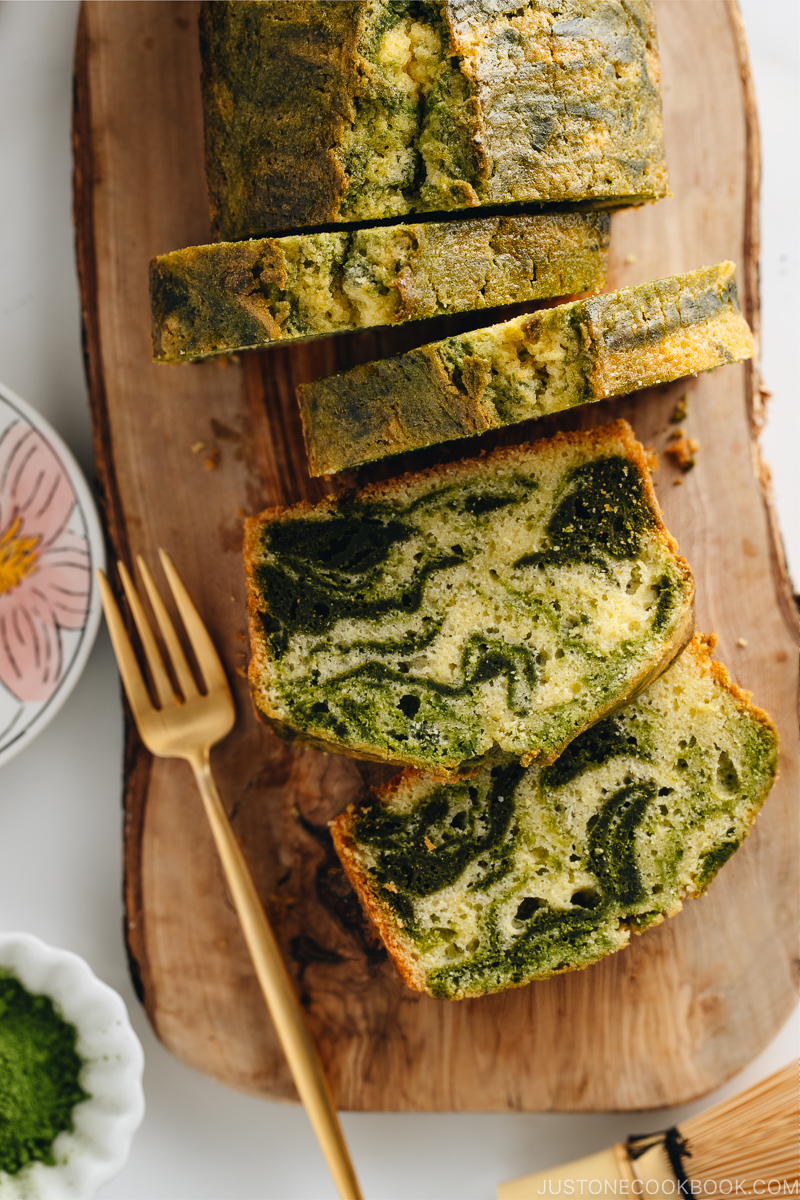
Do you have a good pound cake recipe in your baking repertoire? Today, I’ll show you how to make one of my favorites—Matcha Marble Pound Cake (抹茶マーブルパウンドケーキ).
This Japanese pound cake is buttery, tender, and bursting with a unique green tea flavor. Its striking emerald swirls make it feel like a luscious, special-occasion treat. Whether you’re making it for a Sunday afternoon treat or to take to a party, this Japanese-inspired pound cake will be a keeper!
Table of Contents

What is Japanese-style Pound Cake?
There are a few key differences between a Japanese-style pound cake and a typical pound cake found in the US.
- Japanese pound cake is lighter and less buttery than its heavier and richer American counterpart.
- It has a tighter crumb and firmer structure, whereas the American version has a softer crumb with a looser structure.
- It slices cleanly and holds its shape well, whereas an American pound cake is softer and tends to crumble and break apart more easily.
- It’s best eaten the day after baking. This gives the butter time to oxidize and blend into the cake for a moister texture. Waiting a day also allows the flavors to meld and improve for a stronger matcha taste.
What is Matcha?
Unlike regular green tea, matcha (抹茶) is made from shade-grown tea leaves to prevent direct sunlight. This slows down growth and stimulates an increase in chlorophyll level, which turns the leaves into a darker shade of green. Only the most delicate tea buds are hand-picked, removing the veins and stems. The buds are then stone-ground to the fine, bright green powder.
While green tea is an infusion of tea leaves, matcha powder incorporates the entire leaf, resulting in a more concentrated source of nutrients and caffeine. You can read more about matcha on my site.
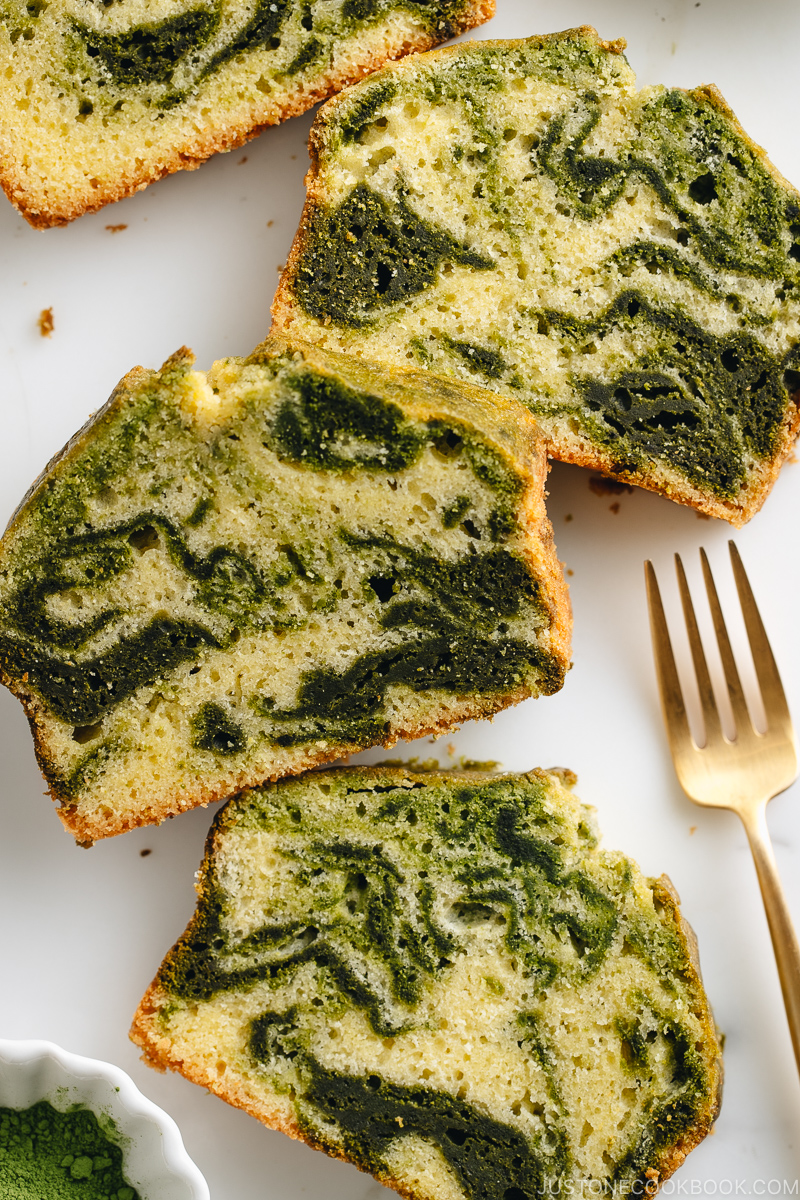
Use Matcha for Baked Goods
With its earthy and slightly bitter undertone, matcha has been used as a mainstream key flavoring in making all kinds of sweets, pastries, and baked goods in Japan. I personally love the flavor of matcha. It’s especially great in baked goods as it keeps the flavor from tasting too sweet.
Another beauty of baking with matcha? The bright green hue lends to the final good that is sure to make an impression.
Ingredients for Matcha Marble Pound Cake
- unsalted butter – at room temperature
- sugar
- large eggs – at room temperature
- cake flour – weigh your ingredients using a kitchen scale
- baking powder
- Diamond Crystal kosher salt
- milk – at room temperature
- matcha (green tea powder)
Substitution for Matcha (Green Tea Powder)
If you do not like matcha or do not want to use it, you can substitute it with pure cocoa powder in this recipe.
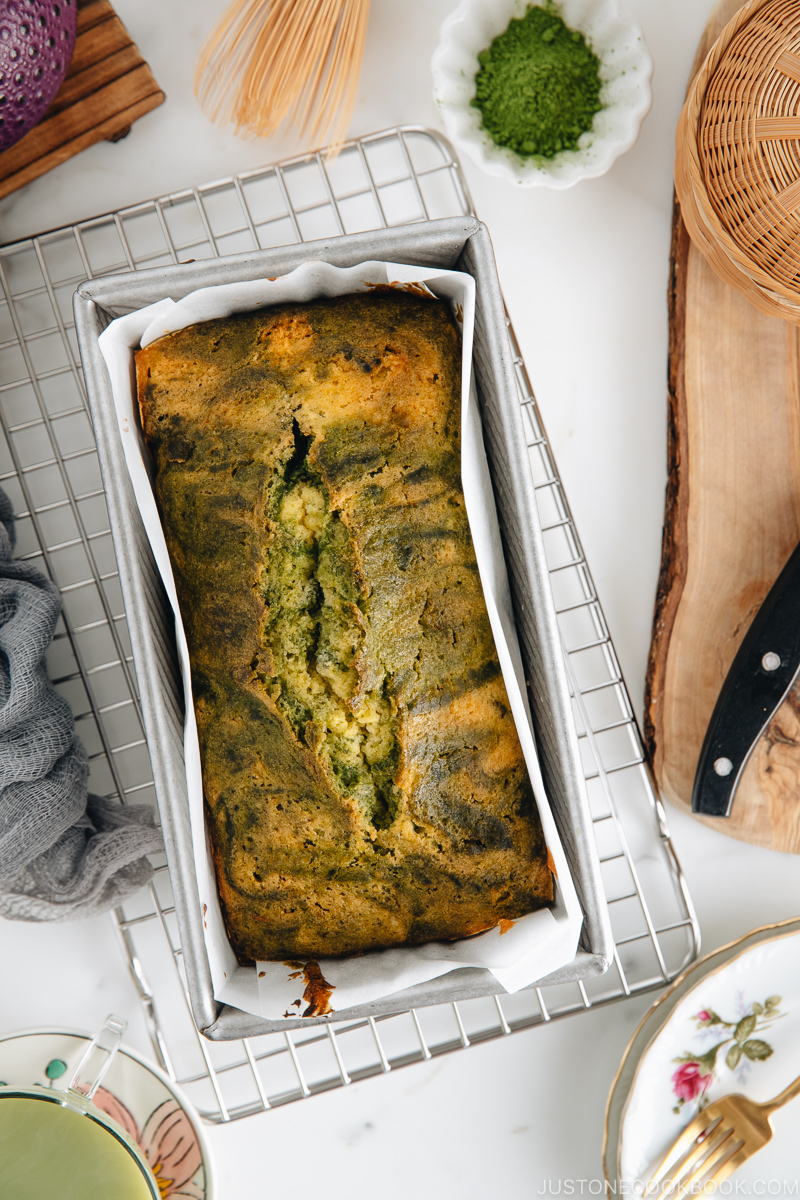
What To Look for When Buying Matcha
- Vibrant green color – It should not be yellowish or brownish green.
- No additives – Sugar and natural flavorings should not be included in the ingredients.
- Grown in Japan – Look for the country of origin for any matcha product.
- Check the expiration date
- Culinary vs. ceremonial grade – For making desserts and baking, you can use “culinary grade” but the color of green will not be as beautiful as “ceremonial grade.” They also have slightly different flavor profiles.
- Package size – Consume matcha within 2–3 weeks of opening. I recommend a package of 1 oz (30 g)—the standard size in Japan. Resist the urge to buy a large package even if it seems like a better deal as you probably won’t use it up before the quality degrades.
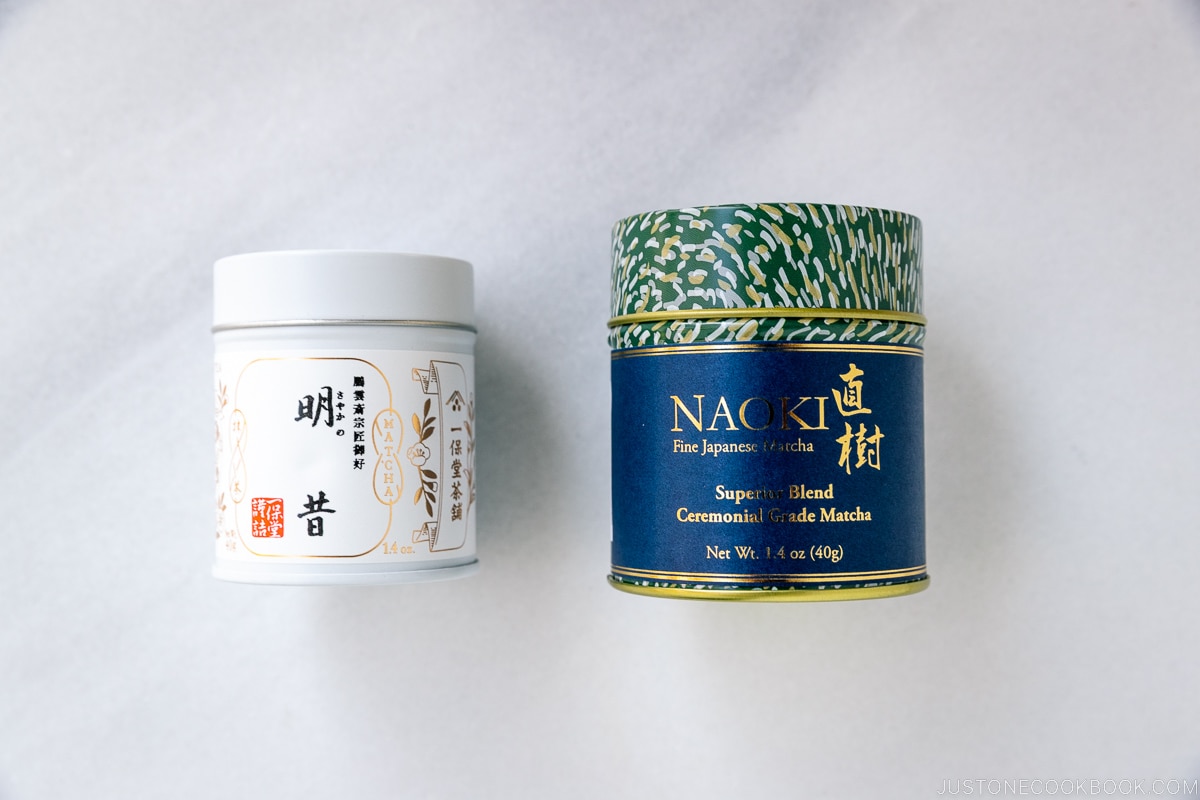
Where To Get Matcha
- Ippodo Tea ($35) – It’s my favorite!
- Naoki Matcha ($23) – I used it in this recipe. I previously collaborated with them for giveaways on the blog and I like their matcha.
- Maeda-en ($11) – It’s decent quality for this price range.
- Japanese grocery stores like Nijiya Market, Mitsuwa Market, and Marukai Market
Use Cake Flour for Japanese Pound Cake
Many American recipes ask for all-purpose flour when making pound cake, but in Japan, cake flour (薄力粉) is always used to make a pound cake. It makes the pound cake extra tender.
To achieve the perfect texture for the pound cake, I used Super-Fine Unbleached Cake Flour from Bob’s Red Mill®. Because it is sifted to a very fine texture, the cake flour is fantastic for all sorts of cakes. You should be able to find this cake flour at any major grocery store. Alternatively, you can also buy it on Amazon.
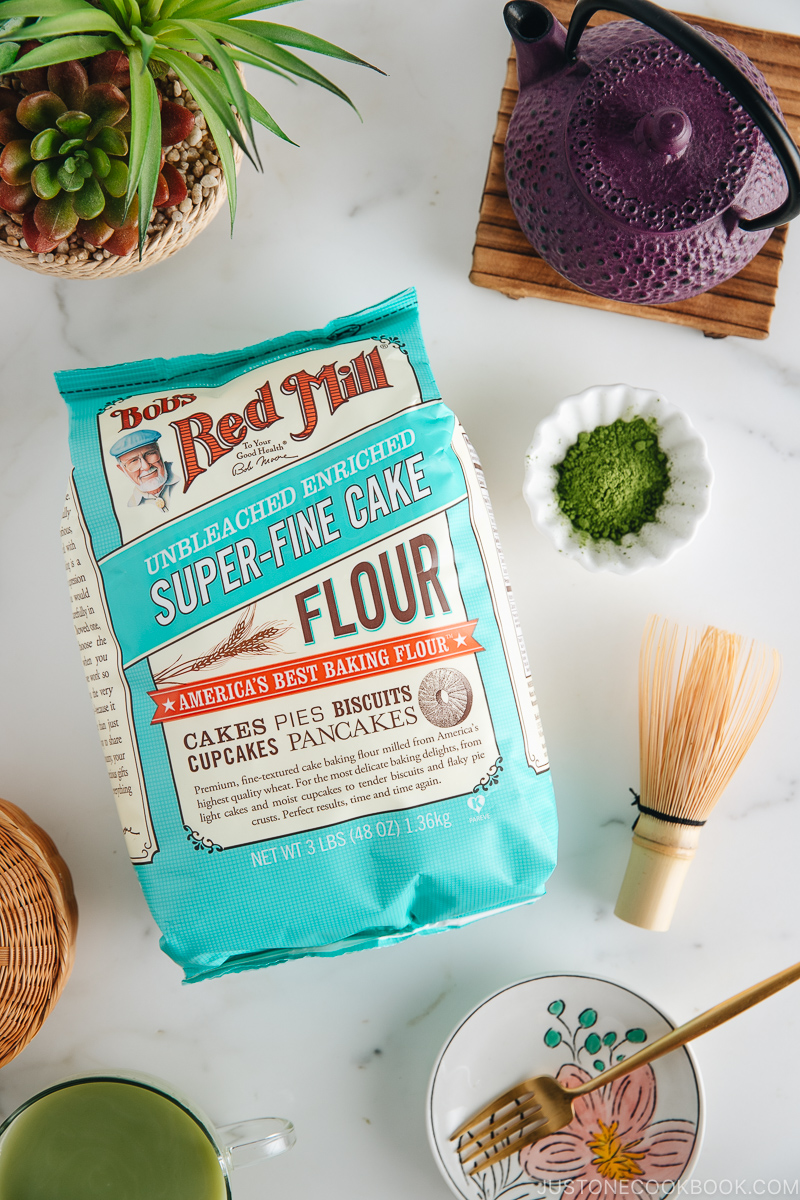
How To Make Matcha Pound Cake
- Preheat the oven. Grease the loaf pan and line it with parchment paper.
- Beat the butter in a large bowl with an electric hand mixer (or stand mixer) on medium speed, then add the sugar to the whipped butter and whisk well.
- Whisk the large eggs in a small bowl and add it 1 Tbsp at a time to the butter mixture, beating well after each addition.
- Add the dry ingredients in three stages using a silicone spatula to fold the mixture by hand just until the batter is smooth.
- Make a paste with the matcha and milk in a separate bowl. Add one-third of the batter to the bowl with the matcha paste and fold together just until you have a homogenous matcha batter. Do not overmix.
- Combine the green and yellow batters to and swirl together to create a marbled pattern.
- Pour the swirled batter into the pan without mixing the batter. Smooth out the surface of the batter with an offset spatula.
- Bake in the oven for 50–60 minutes. After 15 minutes of baking, open the oven and quickly score the top of the cake with a sharp knife.
- Test for doneness starting several minutes before the baking time is up. The cake is done when a wooden skewer inserted in the center of the cake comes out clean.
- Remove from the oven and allow the cake to rest in the pan for 15 minutes on a wire rack. Then, take the cake out of the pan to cool completely.
- Serve it the next day (and up to 3 days after baking) for the best taste and texture. Tightly wrap the cake and keep it in an airtight container at room temperature until ready to serve. Consume within 3–4 days.
5 Tips for Making the Cake Batter
Follow these tips to make sure that the pound cake rises properly and won’t end up with a tough texture.
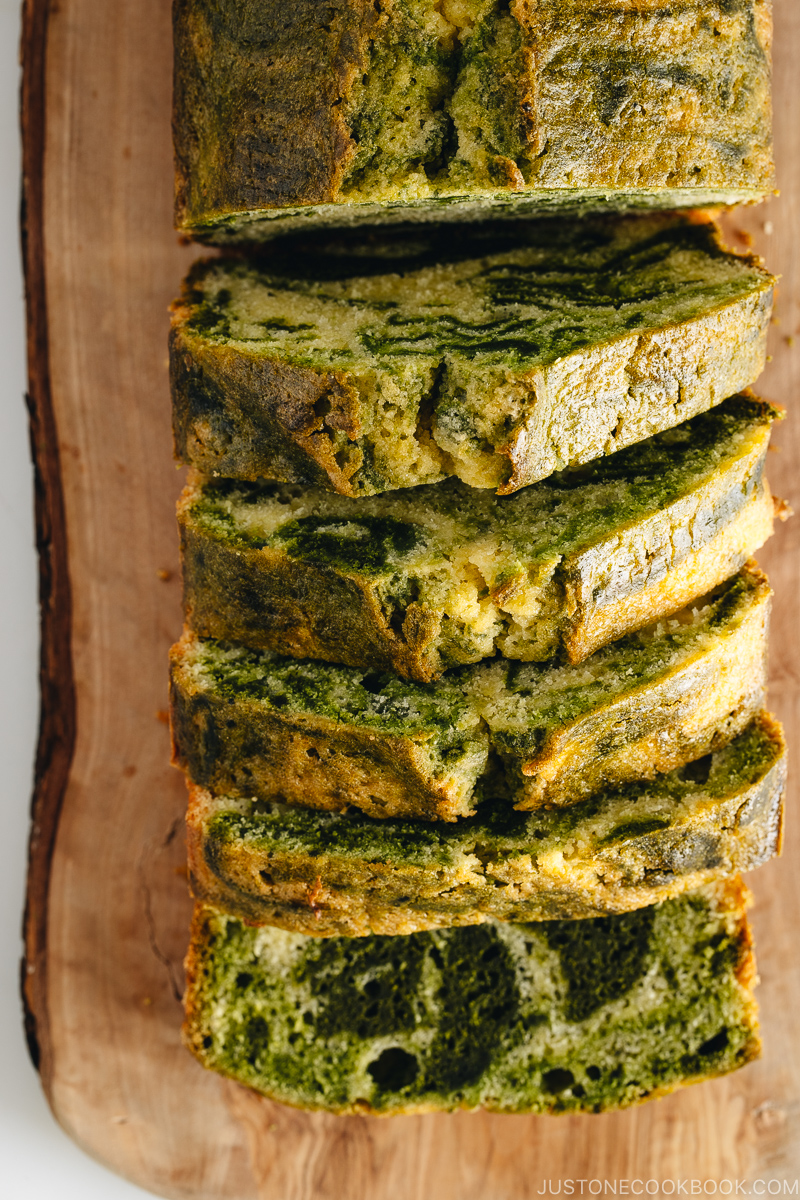
- Use room-temperature butter and eggs to ensure maximum volume. Take the butter out of the fridge and let it sit out on the counter for about 1–2 hours before beginning your recipe. Cold ingredients do not emulsify together. Partially melted butter won’t cream properly. If you forget to take out the eggs from the refrigerator ahead of time, you can submerge the cold eggs in warm (body temperature) water for 10 minutes.
- Cream the butter and sugar mixture until very light and fluffy for a smooth velvety texture. Beat on medium-high to high-speed settings for anywhere from 3 to 7 minutes, depending on a mixer type or hand-held. The sharp sugar grains cut through the butter and create tiny air pockets that aerate the batter and cause leavening. The mixture should be creamy but grainy.
- To avoid a curdled mixture, gradually add a very small amount (1 tablespoon) of the beaten eggs to the creamed butter and beat well after each addition. The eggs contain water, and the yolks and butter are fats. Remember, oil and water will not mix without an emulsifier (in this case, the yolks), which suspends fat molecules in water making a smooth mixture. If there is a slightly curdled appearance to the batter after adding the eggs, don’t worry. The emulsification is usually complete enough that the batter will become smooth. The addition of flour helps as it absorb some of the excess water.
- Don’t overmix the batter once you’ve added in the flour. Once the flour has been added, gluten bonds will start to form and if you mix the batter too much your cake will end up dense, tough, or deflated.
- Fold the batter by hand with a large spatula. Folding is a way of mixing together two ingredients with different densities. Folding helps preserve the lightness and structure of the mixture.
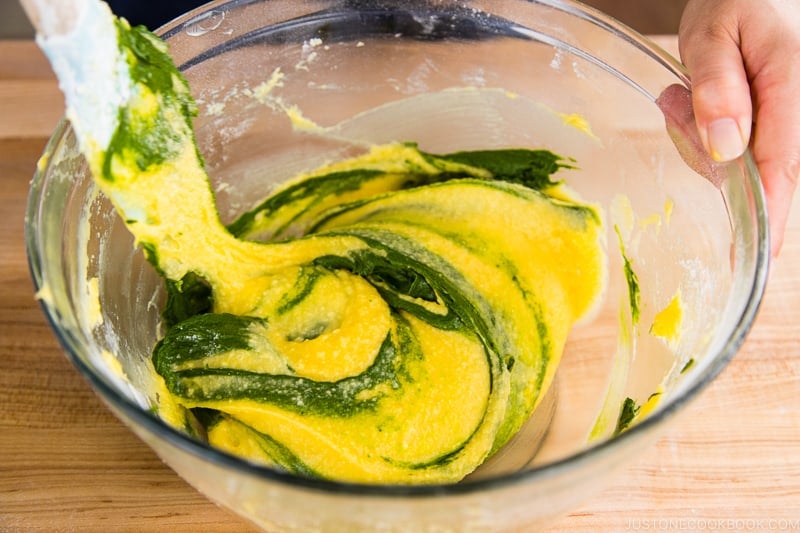
How to Create the Marble Effect for Pound Cake
There are two ways to make a marble effect:
- Make the swirl with the green and yellow batter inside the cake pan.
- Make the swirl with the green and yellow batter in the bowl and then transfer it to the cake pan.
I personally prefer the second method because I can see how the two colors are combined before pouring into the pan. With this approach, I feel that the swirls look more dynamic and you can control the balance of the colors.
Create a Beautiful Crack on Matcha Marble Cake
Did you know the pound cake is supposed to crack on the top? Pound cakes are denser than most cakes, and the exterior starts to bake first. As the heat that is released from the still-baking batter reaches the center of the cake, it needs to expand through the top of the cake since all sides have set. That’s why a pound cake is defined by this rustic crack.
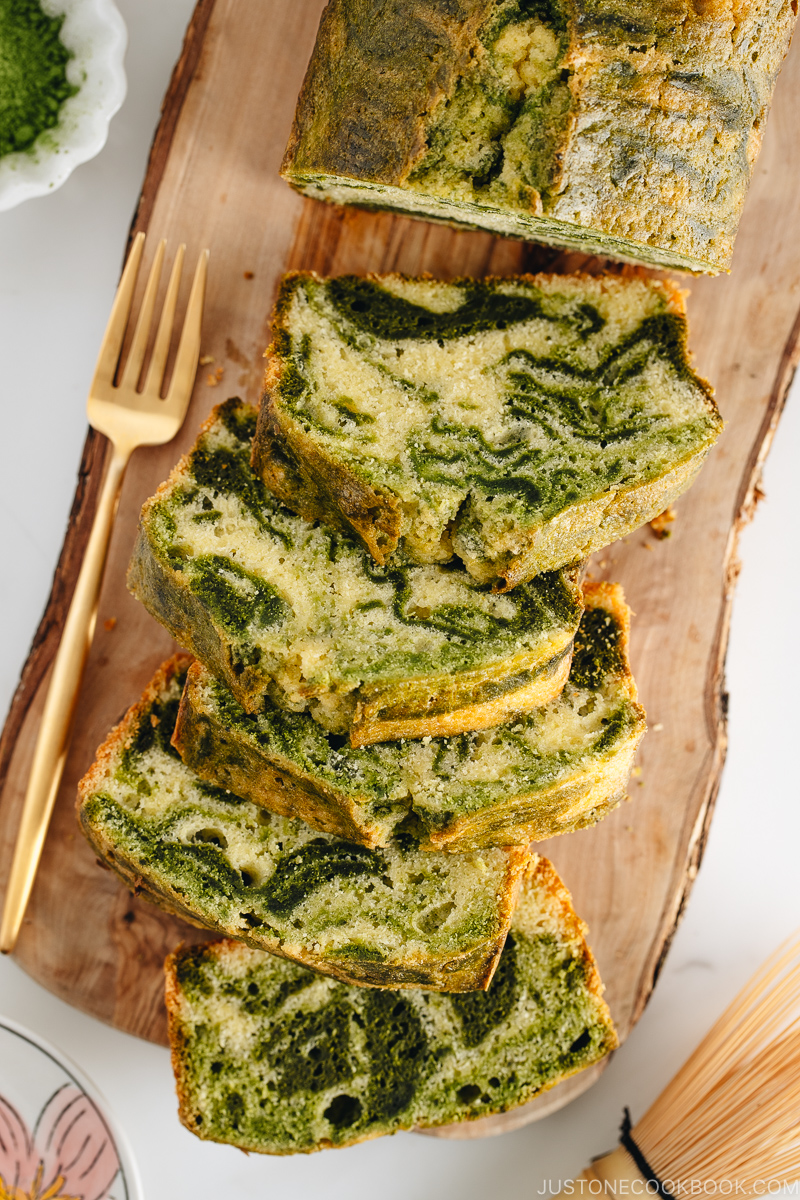
However, the crack doesn’t usually appear perfectly centered in the cake. If you wish to achieve a perfectly cracked pound cake where the rupture sets right in the middle, there are two tricks you can do:
- Trick 1: After 12–15 minutes of baking, insert a knife into the top of the cake batter in the pan and score a straight line. Do it quickly so you won’t lose the oven heat.
- Trick 2: Before putting the cake pan into the oven, cut a very thin strip of cold butter and lay it on top of the cake batter. Or put softened butter into a plastic bag and squeeze it out from a small tip to create a line on the cake batter.
See this image if you need a visual guide. I use Trick 1 as it’s easy to do, but both tricks work beautifully. Since pound cakes are supposed to crack, it’s nice to know how to control the cracking so you get the best-looking pound cake possible.
Other Matcha Recipes
I hope you enjoy this Matcha Marble Pound Cake recipe as much as my family does! It also makes the most gorgeous edible gift if you are thinking of making someone smile today.
- Matcha Latte and Iced Matcha Latte
- Matcha Cookies
- Matcha Basque Cheesecake
- Matcha Ice Cream
- Matcha Swiss Roll
- Matcha Gateau au Chocolat
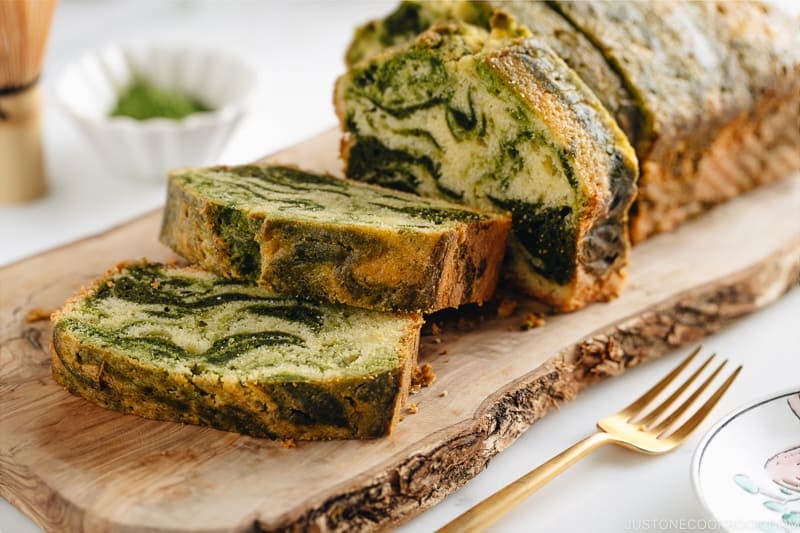
Wish to learn more about Japanese cooking? Sign up for our free newsletter to receive cooking tips & recipe updates! And stay in touch with me on Facebook, Pinterest, YouTube, and Instagram.
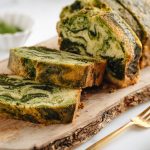
Matcha Marble Pound Cake
Ingredients
- 5.6 oz unsalted butter (1½ sticks, 12 Tbsp; at room temperature)
- 160 g sugar (¾ cup + 2 tsp)
- 4 large eggs (50 g each w/o shell)
- 200 g cake flour (1⅔ cups; weigh your flour or use the “fluff and sprinkle“ method and level it off)
- 1 tsp baking powder
- ¼ tsp Diamond Crystal kosher salt
- ¼ cup milk
- 3 Tbsp matcha (green tea powder) (1 Tbsp matcha is 6 g)
Instructions
Before You Start…
- While you can serve this pound cake the same day you bake it, I strongly recommend that you serve it 1–3 days after baking. The cake will become moister and the flavors will improve. See To Serve below for details.
- Gather all the ingredients. It‘s important that the butter, eggs, and milk are all at room temperature. I highly encourage you to weigh your ingredients using a kitchen scale for this recipe. Click on the “Metric“ button at the top of the recipe to convert the ingredient measurements to metric. If you‘re using a cup measurement, please follow the “fluff and sprinkle“ method: Fluff your flour with a spoon, sprinkle the flour into your measuring cup, and level it off. Otherwise, you may scoop more flour than you need.
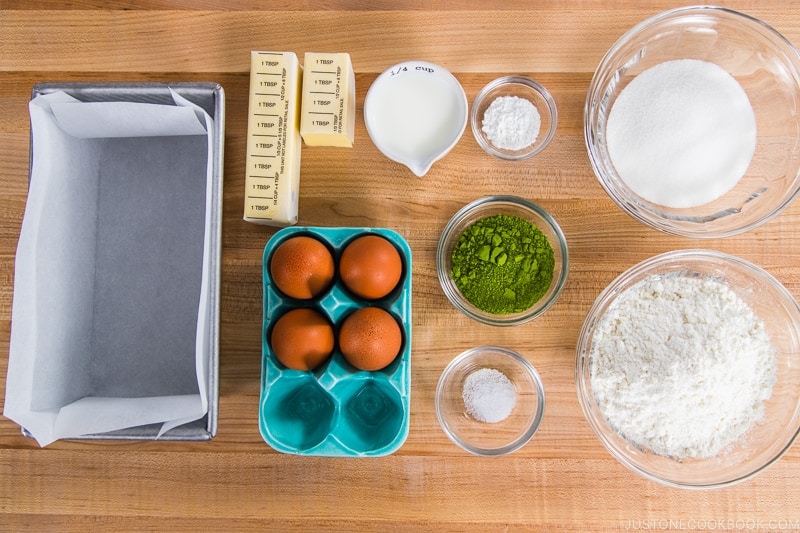
- Center a rack in the oven. Turn on the oven to 350ºF (180ºC) and preheat it well; when the cake pan goes in the oven later, you will lower the temperature to 340ºF (170ºC). For a convection oven, reduce the cooking temperature by 25ºF (15ºC). Tip: I strongly encourage you to check your oven‘s temperature with an oven thermometer, as the actual temperature inside may differ from the display setting.Use the residual butter on the butter wrapper to grease the pan (8½ x 4½ x 2¾ inches). Then, place the parchment paper inside the pan (the paper will stick to the butter). Tip: I recommend using a light-colored pan for this recipe; your cake may bake faster if you use a dark-colored pan.
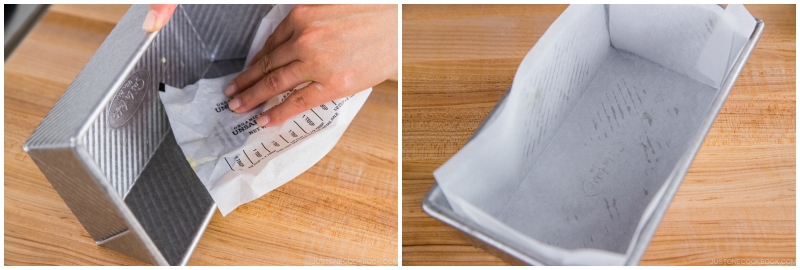
To Make the Batter
- Put the 5.6 oz unsalted butter (12 Tbsp; at room temperature) in a large bowl. Use an electric hand mixer (or stand mixer) to beat it on medium speed until it is light and fluffy, about 1–2 minutes. The butter will be pale in color and have lots of little tails forming around the beaters. Tip: This process adds air to the mixture and is crucial for a light and delicate cake texture.
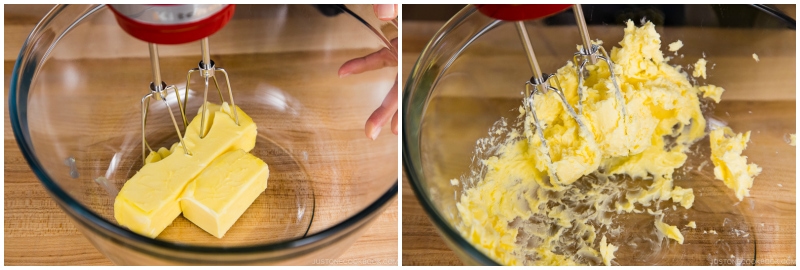
- Add 160 g sugar (¾ cup + 2 tsp) to the whipped butter. Cream the butter and sugar thoroughly on medium (not high) speed, about 5 minutes, until it is light and fluffy. The color is pale and the sugar is completely dissolved. Tip: The sharp sugar grains cut through the butter and create the tiny air pockets that aerate the batter and cause leavening. This process is very important for the light and delicate texture of the pound cake.
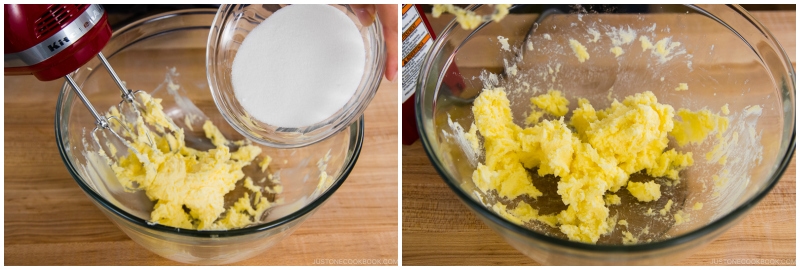
- Crack 4 large eggs (50 g each w/o shell) in a small bowl and whisk well.
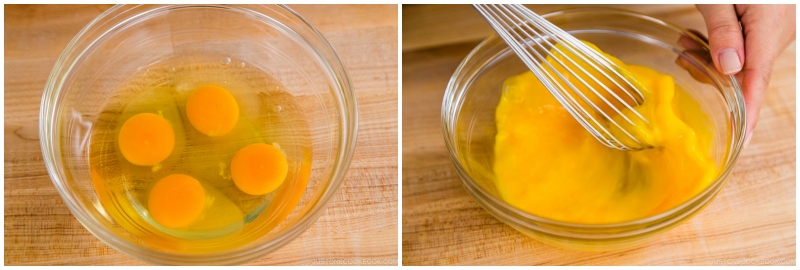
- Add the beaten eggs, 1 Tbsp at a time, to the butter mixture and beat well after each addition. Repeat until all the egg is incorporated. IMPORTANT: You must add and blend only a very small amount of egg at a time to achieve a smooth mixture (not a curdled mixture). Tip: The eggs contain water, while the yolks and the butter contain fats. Remember, oil and water will not mix without an emulsifier (in this case, the yolks) that suspends fat molecules in water to make a smooth mixture.
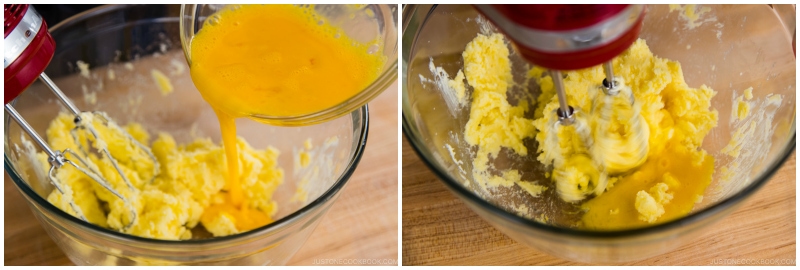
- If there is a slightly curdled appearance to the batter after adding the eggs, don’t worry. The emulsification is usually complete enough that the batter will become smooth when you add the flour. The flour helps to absorb some of the excess water, too.
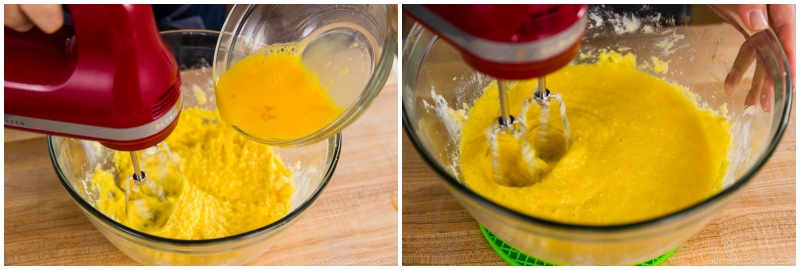
- Next, add the dry ingredients in three stages. Put 200 g cake flour (1⅔ cups), 1 tsp baking powder, and ¼ tsp Diamond Crystal kosher salt in a fine-mesh sieve. Sift one-third of these dry ingredients into the bowl of the egg mixture. Switch to a silicone spatula (or use a mixer on the lowest speed) and fold the mixture by hand so you can scrape the bottom of the bowl to get any dry pockets of flour.

- Now, add another one-third of the dry ingredients and fold again.

- Finally, stir in the remaining dry ingredients. Fold it just until the batter is smooth. Tip: Even though we are using a low-protein cake flour, excess mixing will develop the gluten and the cake will rise nicely in the oven, then sink as soon as you pull it out. A sunken cake has a tougher crumb with dense, moist, and gluey streaks.

To Incorporate the Matcha
- Next, make a paste with the matcha: Heat ¼ cup milk in a microwave or saucepan until warm (roughly body temperature). Gradually add the milk, 1 Tbsp at a time, to 3 Tbsp matcha (green tea powder) in a medium bowl. Whisk well until combined. Optionally, you can sift the matcha in a fine-mesh sieve first before mixing with the warm milk. Tip: Warm liquid is easier to blend with matcha.
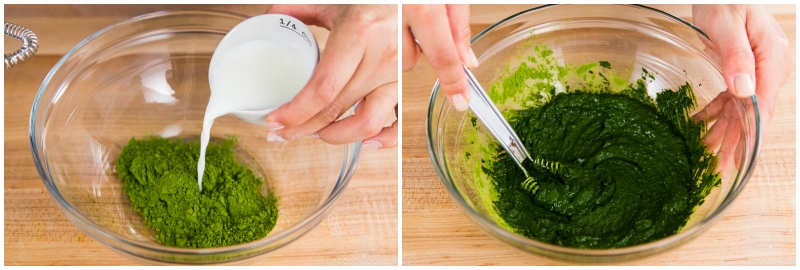
- Add one-third of the batter to the bowl with the matcha paste.
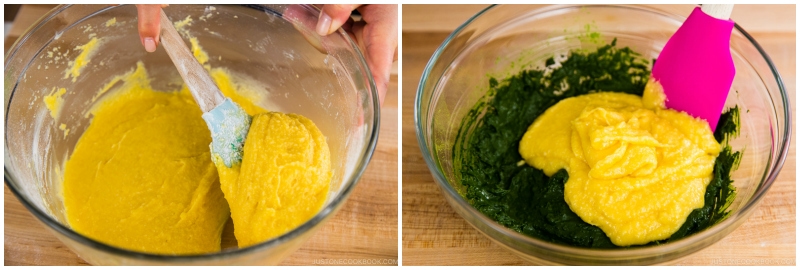
- Use a silicone spatula to fold the batter into the matcha paste just until the it's smooth and homogenous. Do not overmix.
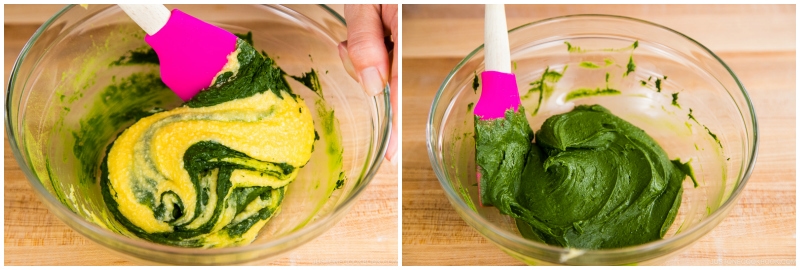
- Now, combine the green and yellow batters to create a marbled pattern. Add the matcha batter to the original yellow batter in 6–8 separate dollops scattered around the bowl. To swirl the two batters, use a silicone spatula to scoop the batter from the bottom of the bowl and fold it onto itself while rotating the bowl a quarter turn. Repeat this two more times only.

- Pour the batter into the cake pan without mixing to keep the swirl effect. Tap the pan on the countertop once to release any air pockets.
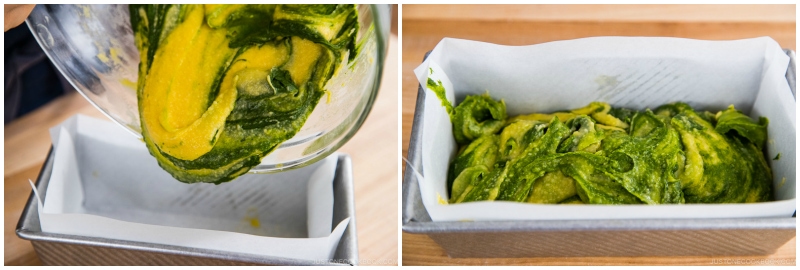
- Using an offset spatula, lightly smooth out the surface of the batter without mixing too much.
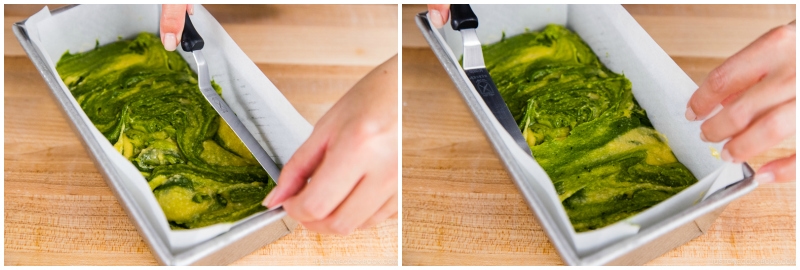
To Bake
- Put the cake pan in the oven. Lower the oven temperature to 340ºF (170ºC) and bake for 50–60 minutes. Tip: Every oven is different, and your cake may be done in less than 50 minutes, so I recommend that you start testing for doneness several minutes before the baking time is up. If you‘re using a dark-colored pan, the cake may bake faster and your baking time could be shorter by 5–10 minutes or more.
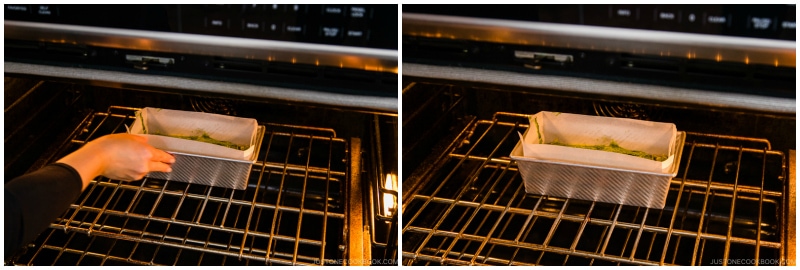
- After 15 minutes of baking, open the oven and quickly score the top of the cake with a sharp knife. (Please read the blog post about why we do this). Continue to bake, monitoring the oven to maintain a temperature of 340ºF (170ºC).
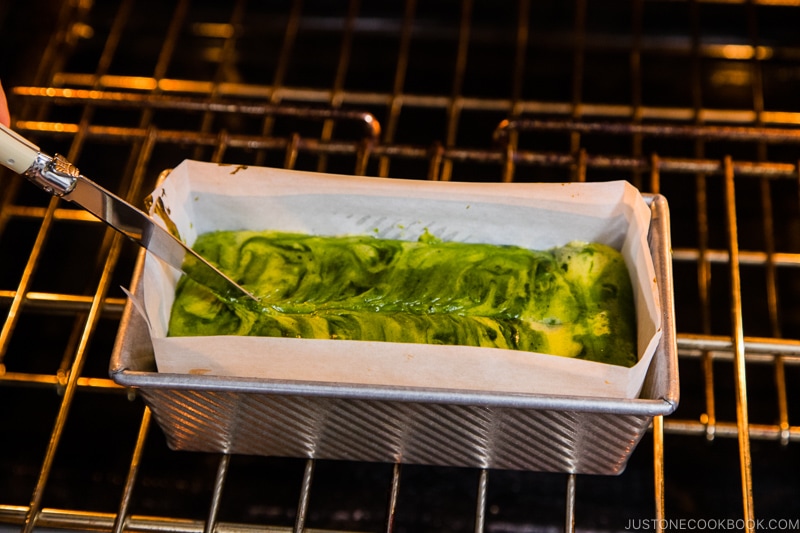
- The cake is done when a wooden skewer pulls out moist crumbs (not wet batter) when inserted near the center of the cake. Tip: To prevent overbaking, start checking for doneness several minutes before the baking time is complete.
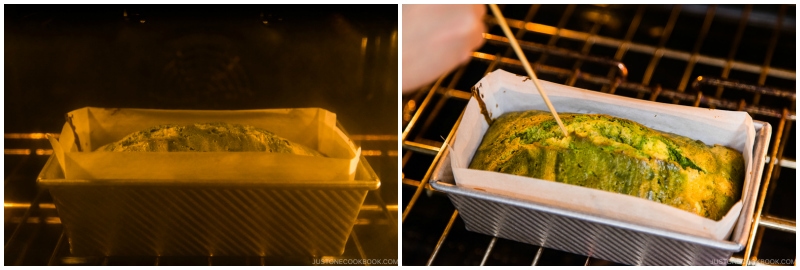
- Remove from the oven and allow the cake to rest in the pan for 15 minutes on a wire rack. Then, take the cake out of the pan to cool completely.
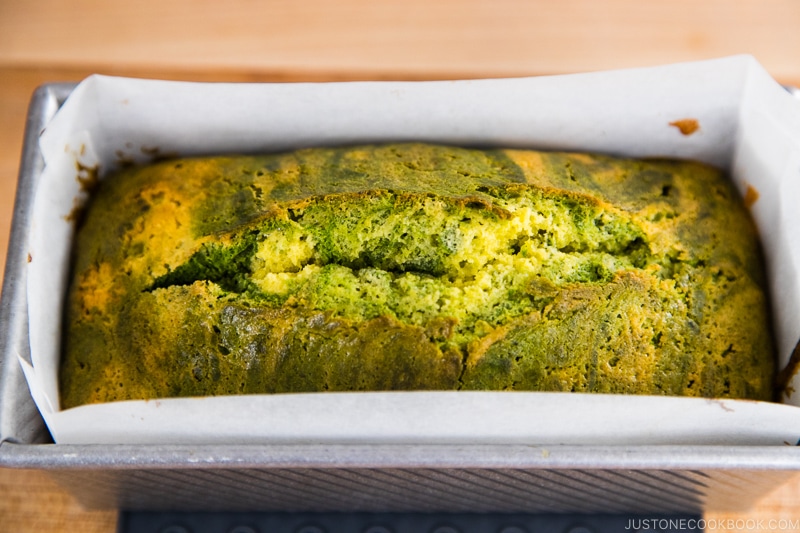
To Serve
- Once it’s cool, you can slice and serve the Matcha Marble Pound Cake, if you wish. However, I strongly recommend serving it the next day (and up to 3 days after baking). This gives the butter time to oxidize and blend into the cake, resulting in a moister texture and allowing the flavors to meld and improve for a deeper matcha taste. Tightly wrap the cake and keep it in an airtight container at room temperature until ready to serve.
- You‘ll notice some differences between this Japanese-style pound cake and a typical American pound cake. The Japanese version is lighter and less buttery than its heavier and richer American counterpart. Also, a Japanese pound cake will have a tighter crumb and firmer structure. Finally, the Japanese version will slice cleanly and hold its shape well, whereas an American pound cake is softer and will crumble and break apart more easily.
To Store
- Store the pound cake at room temperature and consume it within 3–4 days. In a hot and humid environment, store it in the refrigerator for up to 1 week or in the freezer for 1 month.
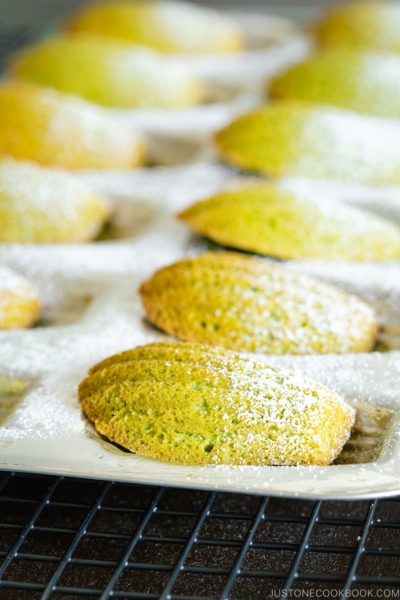
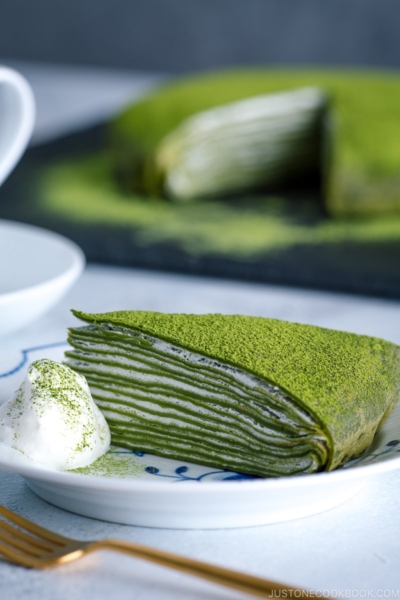
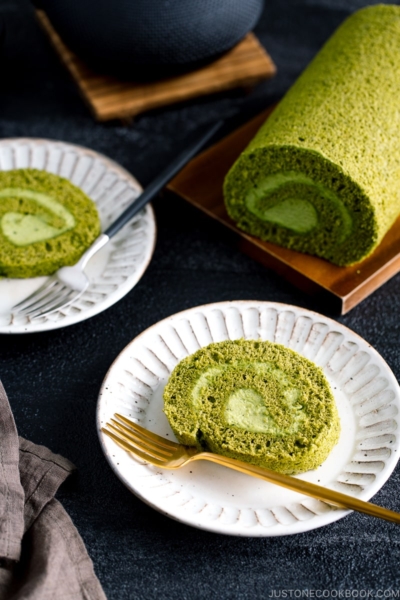
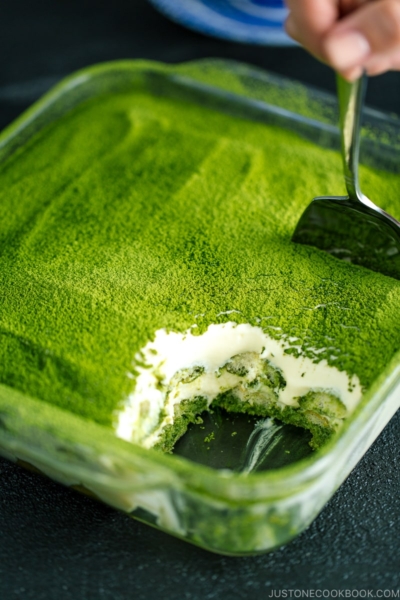




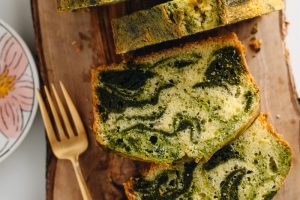
So delicious. I am very happy with how this turned out. It’s tender and moist but not overly greasy or buttery like some other recipes. The taste is really exquisite. It has a subtle but deep flavor. I used ceremonial-grade matcha that’s sweet and not bitter, and I think the higher quality makes a huge difference in the outcome. Someone had commented that their cake was dry, so I watched my oven temperature like a hawk. My oven got hotter as time went on, so I turned it down so the thermometer inside the oven stayed at 340F. I weighed all my ingredients in metric. I also checked it early/often to see if it was done so I wouldn’t miss the window–I poked it at 45 minutes, then at 50 minutes, and finally took it out at 54 minutes. I can see how it would be easy to over-bake if you don’t keep an eye on things. The sides and bottom were on the verge of becoming dry. Next time, I will take it out of the oven a minute or two sooner so that it’s a little less baked on the sides and the same light brown color as yours. I wonder if this same recipe would work with cocoa or hojicha powder, so I will try that sometime, too. Thank you!
Hello Kumi! Your cake looks absolutely delicious! Thank you for trying out Nami’s recipe and sharing your photo and kind feedback.☺️
It’s important to keep a close eye on the baking time since every oven behaves differently. We’re glad you did so for this recipe!
As for different flavors, we haven’t tested them yet, but we believe that using cocoa and Hojicha powder would work well. If you decide to give it a try, please let us know how it turns out!
I made this pound cake with hojicha powder this time instead of matcha. It’s quite delicious and I love it. It has a subtle roasted flavor and the slightest pleasant bitterness. I also used 1 Tbsp extra butter and 1 Tbsp extra sugar in the batter for a little more richness. I will make this again!
Hello, Kumi. Aww. We’re delighted to hear that Hojicha powder made this cake delicious as well. 🤩
Thank you for trying it and sharing your baking results with us. This information will be useful to other readers who may want to attempt.
Happy baking!😃💞
hojicha marble pound cake
Wow! What a beautiful cake! Kumi, thank you for sharing the image with us!😍
That’s the best matcha marble recipe! I followed the steps to the dot and kept an eye on the cake throughout the baking time. The cake is super soft and fluffy and as per the recipe, it does taste much better the next day. Thank you for the recipe
Hi Yee! Aww. We are so happy to hear you Nami’s recipe was the best!
Thank you for trying her recipe and sharing your feedback with us. It means a lot to us. Happy baking!
Just made this recipe! I use 11 grams of matcha since I felt it was too much, and I cook it for 40 minutes. I also add some vanilla to give some flavour.
Hello, Monica! Thank you for trying Nami’s recipe and sharing your experiences with us! 🤗
Hi,If I use less sugar like 100gms would it be okay .?
Hello, Tooba. Thank you for trying Nami’s recipe.
You may reduce the amount of sugar, but the cake’s texture will be drier. We hope you find the perfect balance of sweetness to your liking. Happy Baking!
Light, fluffy, and flavorful cake. I followed your directions exactly and had great results. I couldn’t resist having a slice as soon as it cooled. It was good, but when I tried it the next day it was even better–richer & moister. You’re so right about waiting. I’ll definitely make this again. Thanks!
Hello, Selena. Thank you for reading Nami’s post and using her recipe!
We are delighted to hear Nami’s advice was helpful. We hope you will continue to enjoy this recipe. Happy baking!🤗
It takes 9 pages to print— could you condense a little? BTW great recipe
Hello, Carol. Thank you for using Nami’s recipe.
The top of the print page includes the option to decide how you want to print. You can also remove the step-by-step images and alter the size of the wording.
We hope this information is helpful!
Hi! I used way too much ceremonial grade matcha powder (4-5 tsbp) and was worried it would be bad but it was still so good! Super fluffy and saved the recipe for the future. I think it would be a great base for matcha pandan! Thank you so much!
Hi Donna! We are so happy to hear you enjoyed Nami’s recipe!
Thank you for trying her recipe and for your kind feedback!
Can this recipe be made in a bundt pan?
Hi, Charlotte! Thank you for trying Nami’s recipe.
This recipe is made to fit 4 cups of cake butter. So, if you modify it to fit your bundt pan, it should be OK.
Enjoy!
Hi I tried this recipe several times in the past few years. Every time it comes out of the oven beautifully but by the time it cools down, it shrinks and the cake becomes dense. Any suggestion?
Hello there! Thank you very much for trying Nami’s recipe.
Overmixing the batter often causes the cake to shrink and become dense. We recommend going over Nami’s Tips for Making Cake Batter to check if you overlooked anything. Make sure you use cake flour and weigh it on a scale for greater precision.
We hope this helped! 🙂
I used self raising flour and it turned out very dry. Tried twice and the results were the same. Can self raising flour make it dryer?
Hello, Stephanie. Thank you for attempting Nami’s recipe.
We have never tried this recipe with self-rising flour previously, so we are unsure of the outcome.
Because self-rising flour already includes baking powder and salt, it may react differently. We hope you will try this recipe with cake flour.
I weighed all my ingredients metric measurements and the cake turned out beautifully. Thank you Nami for your meticulous and painstaking instructions, and above all, for sharing the success of what makes for a tasty pound cake. 🙏🏻🙏🏻🙏🏻🧧🧧
Hi Yvonne! We are so happy to hear you enjoyed Nami’s recipe.
Thank you so much for trying her recipe and sharing your experience with us.
Happy Baking!
Hello
can I make this with gluten free flour?
Hi Lauren! Thank you for experimenting with Nami’s recipe.
Gluten-free flour may work, but we have never tested it before. Please let us know how it goes if you attempt it! 😃
I just came in here to say that you guys severely messed up the Metric measurements. 200g of flour is NOT 1 2/3 cups of flour (as per the US measurements), it’s more like 0.85 of a cup. Unfortunately, I learned this the hard way after 15mins of baking and now the recipe is ruined. Definitely won’t be using any recipes on this site going forward, you guys really messed this up… Why have the metric option if it’s not at all accurate?
Hi Gary! Thank you so much for trying this recipe. I’m sorry yours didn’t come out well.
I use a kitchen scale and metric for the majority of my baking recipes including this one. I write cup measurements for American readers who still like to use a dry measuring cup.
Anyway, 200 g is correct for this recipe. 1 cup of cake flour is 120 g, so 200 g is 1 2/3 cup.
I’m not sure what went wrong if you measure ingredients properly using a scale. But I’m happy to provide assistance if you could share more information. 🙂
Hello, Gary. We’re sorry to hear your cake didn’t turn out as great as you hoped.
The weight of cake flour differs from the weight of water, and 1 cup is not 0.85 cup as you weigh water.
We hope you will give it another try!🙂
Measured everything on a scale, baked for 50-mins exactly, SO incredibly dry; definitely disappointing.
Hi, Caro. Thank you for trying Nami’s recipe.
We’re sorry to hear that the cake was extremely dry this time.
First, we recommend checking the oven’s internal temperature to ensure that the oven display shows the correct temperature (340ºF or 170ºC) when you bake them.
Another suggestion is to reduce the baking time in your oven.
We hope this helps!
I made this today and I made it into muffins instead of a cake shape. (I love everything muffin-shaped!)
It is so delicious !!!!
Hi Andrea! Thank you for experimenting with Nami’s recipe!
The muffin shape must be very cute with a marble Matcha color. Thank you for sharing your experience.😊